Liverpool has now set a new club record, 64 consecutive home wins in the Premier League after they saw off Leicester City 3-0, before this game Leicester had a 100% record on the road this season.
After the match Liverpool boss Jürgen Klopp said he was pleased with his sides “overall performance”, considering how depleted his side looked missing regular starters on the back of an international break. Doubling their xG of 1.63, the Red’s ran out worthy winners after a convincing performance.
In stark contrast, Foxes boss Brendan Rogers admitted his side were ‘too passive’ and ‘lacked aggression’ in the first half. Rogers made a tactical change to a 4-2-3-1 to get his side back in the game in the last 30 minutes. However, it was not enough to unlock the new-look Liverpool defence. It was the manner of the goals conceded that hurt Rogers the most, goals coming from three crosses, two of which were set-pieces, an area of their game Roger’s considered a strength.
The tactical analysis below looks at the major tactics and talking points from this game. As well as looking at key players and key moments, our analysis highlights how both managers set their sides up to nullify the opposition and get success.
Lineups
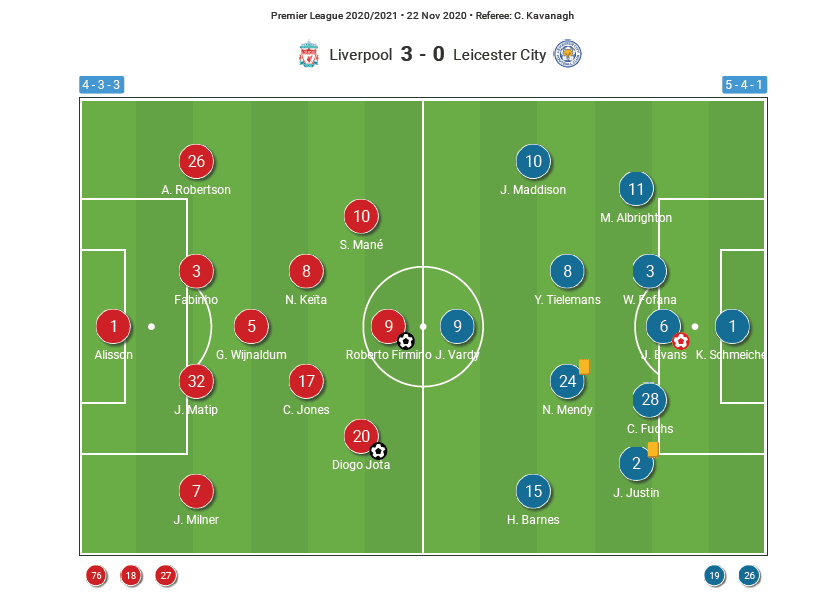
Liverpool: 4-3-3
Liverpool was quite strong, considering the first choice personnel that were absent due to injury layoffs and positive COVID testing. Diogo Jota, Roberto Firmino and Sadio Mané made completed a strong front three. Just behind a high energy trio of Georginio Wijnaldum, Curtis Jones and Naby Keïta were crucial to Liverpool’s game in and out of possession. Andy Robertson and James Milner operated on the flanks while Joel Matip and Fabinho protected the tried and trusted Alisson Becker in goal.
Leicester City: 5-4-1
Similarly, Leicester was missing three of there regular starters at the back. Nonetheless, Rogers fielded what he believed was a competent and capable back-five. Jonny Evans marshalled the defence as centre-back while Christian Fuchs and Wesley Fofana played to the left and right respectively. James Justin and Marc Albrighton operated on the flanks as wing-backs, while Nampalys Mendy and Youri Tielemans played in central midfield. The inverted wide midfielders Harvey Barnes and James Maddison supported the lone striker Jamie Vardy.
Liverpool attack a passive back five
Due to Leicester’s 5-4-1 defensive shape, Liverpool was offered half of the field in their build-up. While Leicester’s one striker and four midfielders couldn’t move quick enough to defend Liverpool’s quick lateral passes across the field, the Red’s frequently got into the final third with ease.
Fluid rotations between the midfield three and the front three made Liverpool’s forward difficult to mark and close down when receiving the ball, oftentimes, they were afforded the opportunity to turn and play forward with little pressure.
Considering Leicester’s low-intensity defending, Liverpool were better able to identify and discover better passing opportunities as well as penetrating passes into the final third as a result. Particularly in the first half, Liverpool looked dangerous combining through the middle, going wide and delivering crosses as well as on the counter-attack, creating chances from each of these moments.
The five images below offer a good example of how Liverpool started the build-up, switched the play to advance forward, combine in the middle and get a shot on goal. A four-pass move starting with the centre-back and ending with the right-forward having a shot on the edge of the box in a matter of seconds.
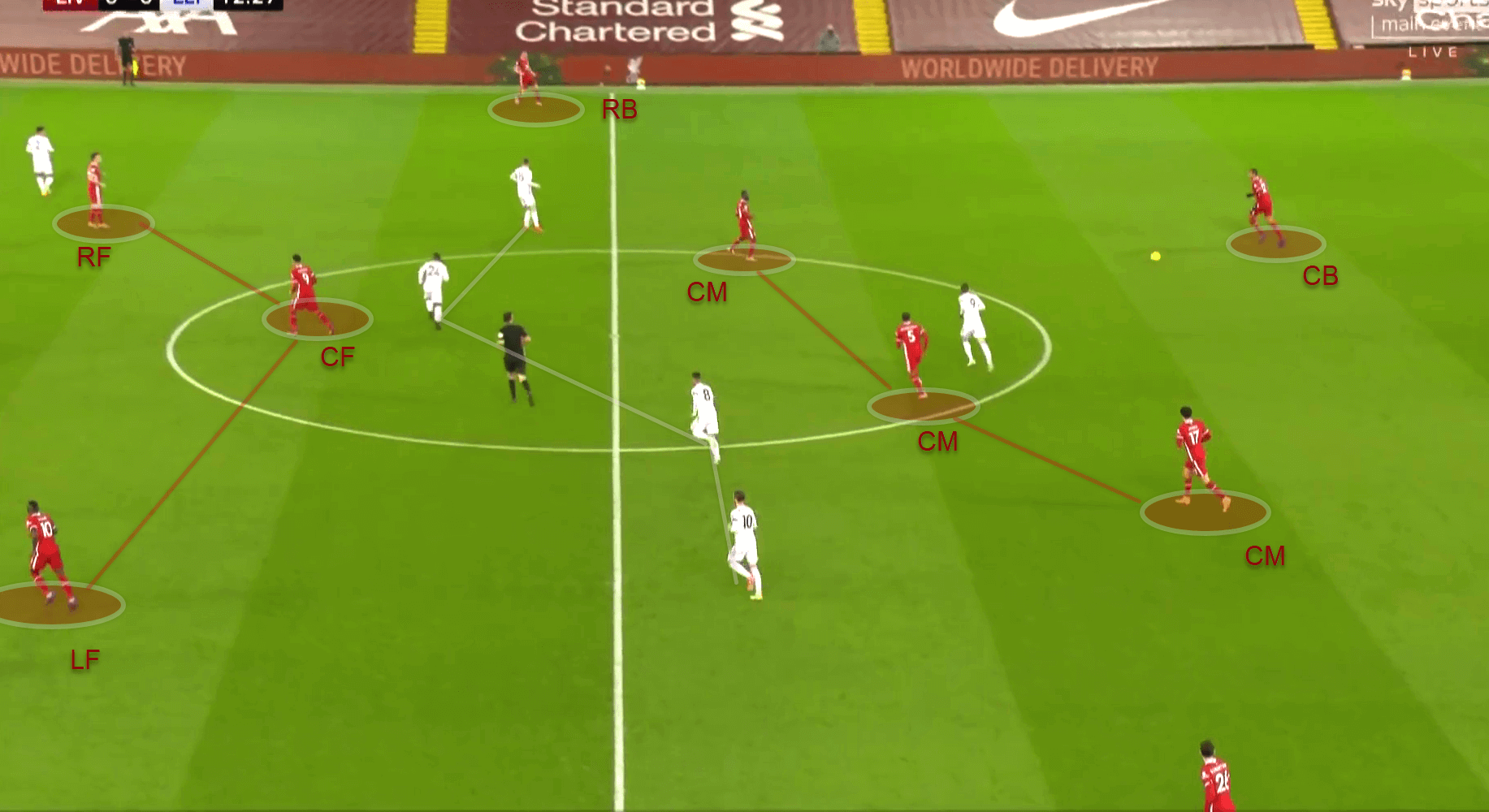
In Fig. 1, we see Matip advance forward in possession towards the halfway line under no pressure. Observe the balanced shape of Liverpool at this point., centre-forward Firmino comes short to overload the midfield while both full-backs push into the Leicester half. One of the Liverpool centre-backs is out of frame at this point.
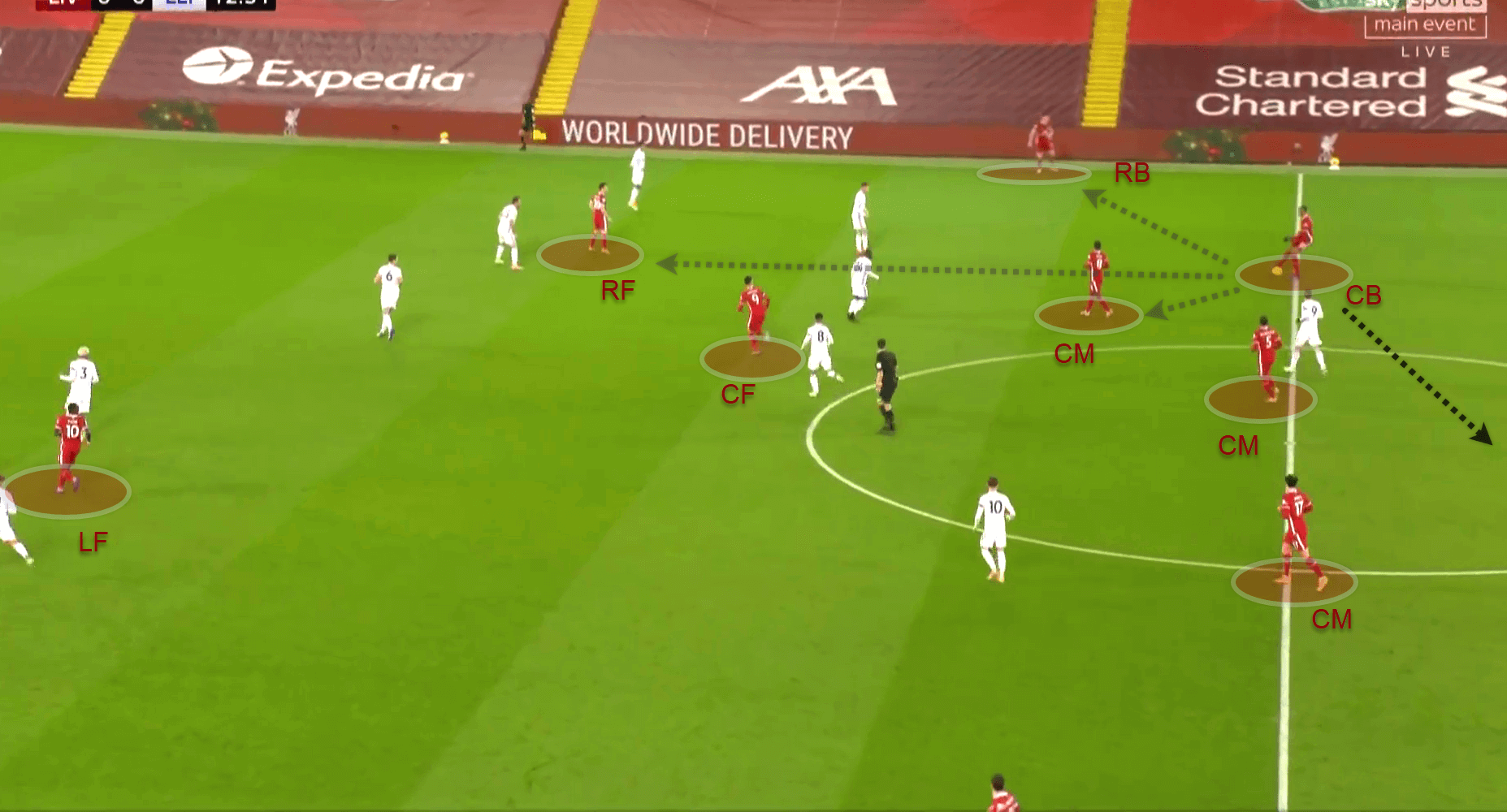
In Fig. 2, Matip slows his run and assess all passing options forward, the dim grey broken lines represent potential passes for the player in possession. Notice, the multiple passing options mean Leicester have to shift across to that side to get compact. At which point Matip plays a lateral pass across, where the play will eventually reach the opposite flank.
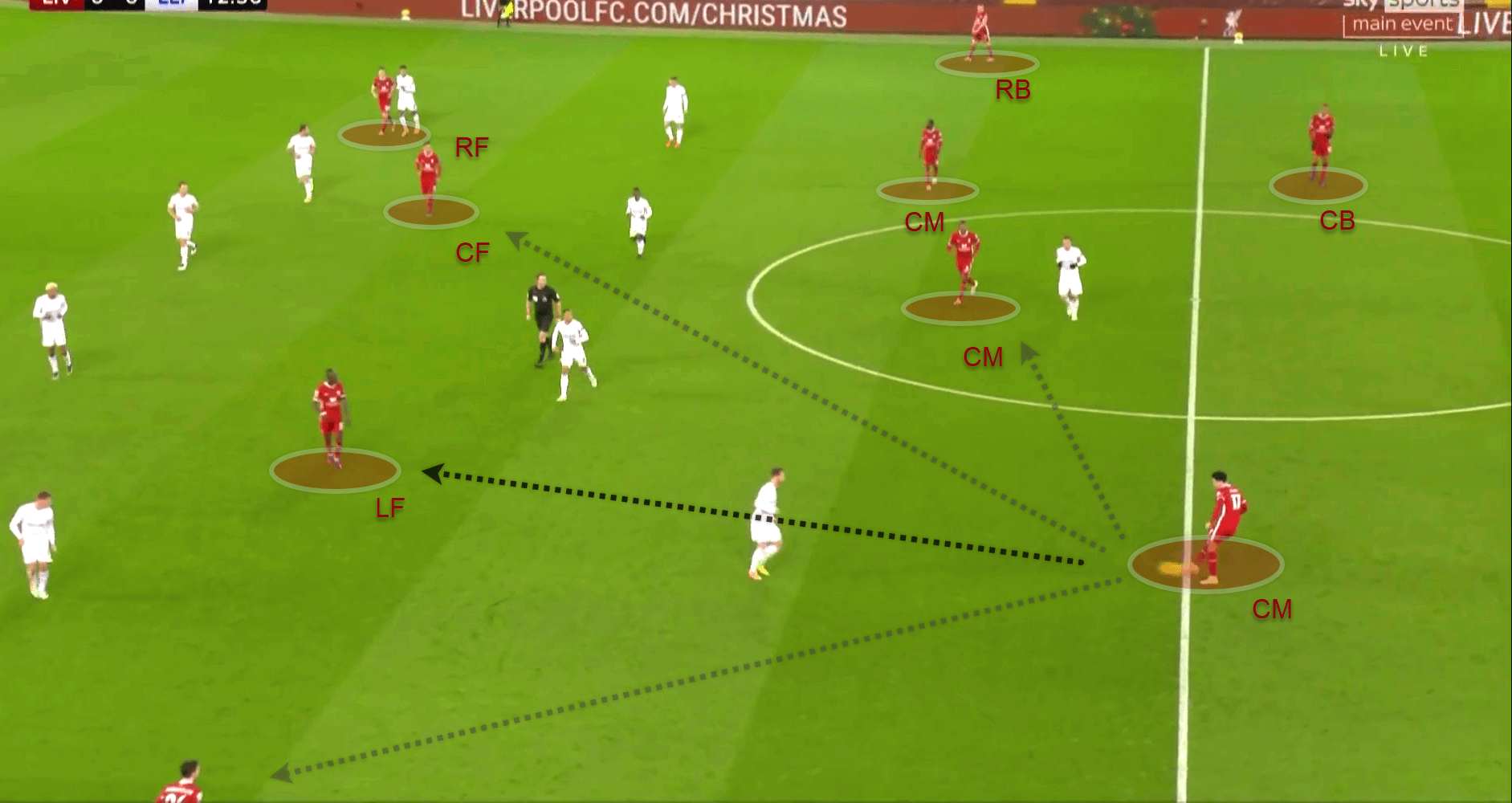
Above, in Fig 3. We see Jones ‘CM’ has received the ball in a deeper position. As Leicester are still shifting back across, observe the midfielders passing options, outlined by the broken grey lines. On his second touch, Jones plays a short pass forward to Mané, who subsequently turns and dribbles at the Leicester backline.
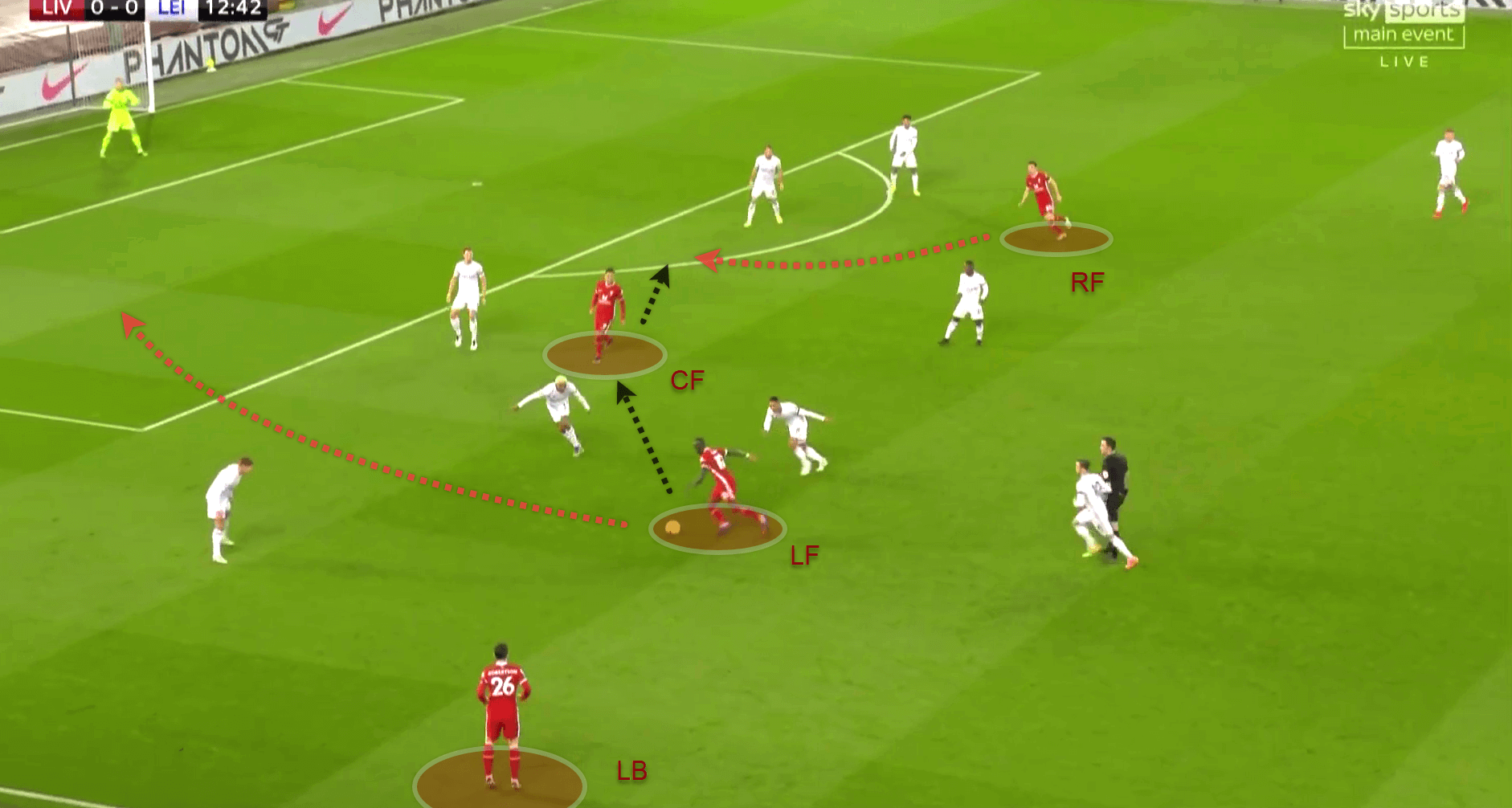
Above, we see Mané wastes no time in exploiting the space, Firmino ‘CF’ has moved across the defence losing his defender, at which point Firmino can receive a forward pass unmarked. Mané passes and continues his run into space. Upon receiving the ball, Firmino turns quickly to offer a forward pass to the ‘RF’ Jota.
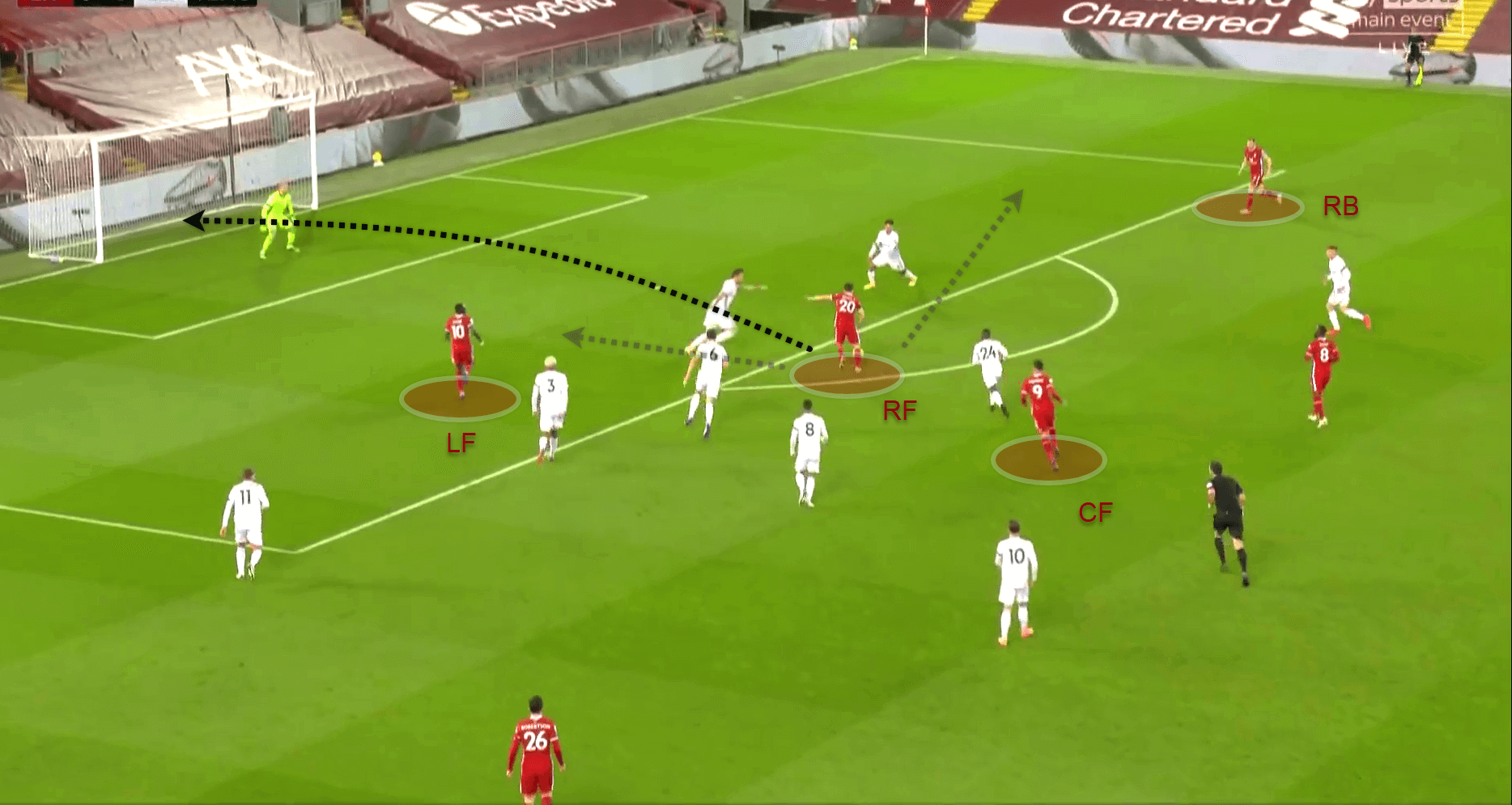
In Fig. 5, we see Jota has adjusted his body and prepares to take a shot on his second touch. Observe by the grey lines Jota’s passing options forward into the box. At this moment, Leicester’s goalkeeper is called into making a good save to deny Liverpool a goal. In a matter of seconds, a four-pass move from the halfway line resulted in Liverpool nearly scoring a goal. Each of the above images offers many examples to Brendan Rogers point about being “too passive” and “lacking aggression”.
Below we highlight two examples of Liverpool’s danger going forward; first, we show Liverpool’s movement and intensity in the transition to attack followed by a crossing opportunity.
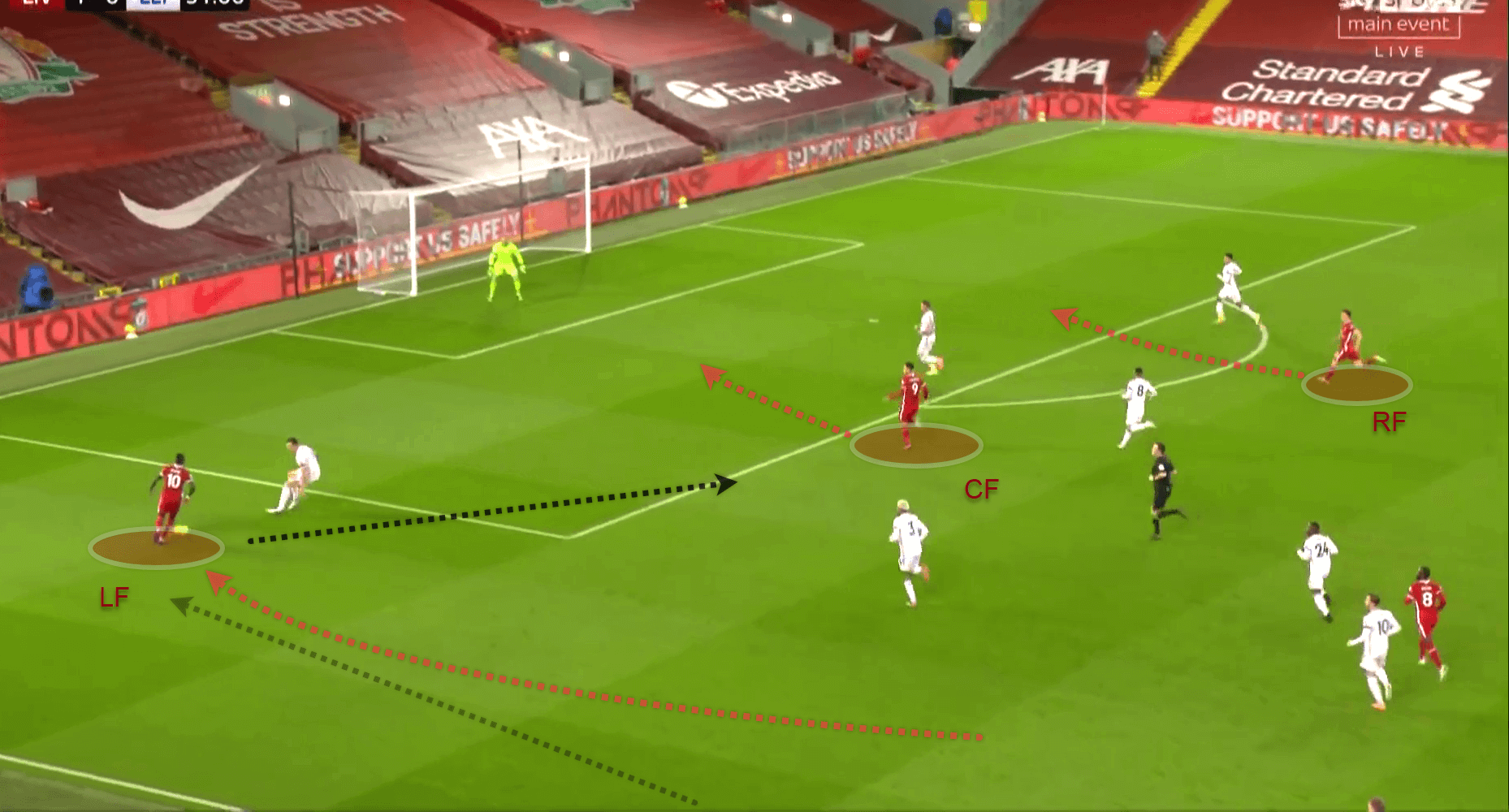
Above, in Fig. 6. Mané latches onto a through ball played from just inside the Leicester half by Jones. Right-footed Left-forward Mané turns inside to discover passing options and supporting runs. The Foxes defender screens the pass to the ‘CF’ Firmino, at which point Mané looks to dribble past Evans into the box, Evans fouls and Liverpool have a free-kick on the edge of the box.
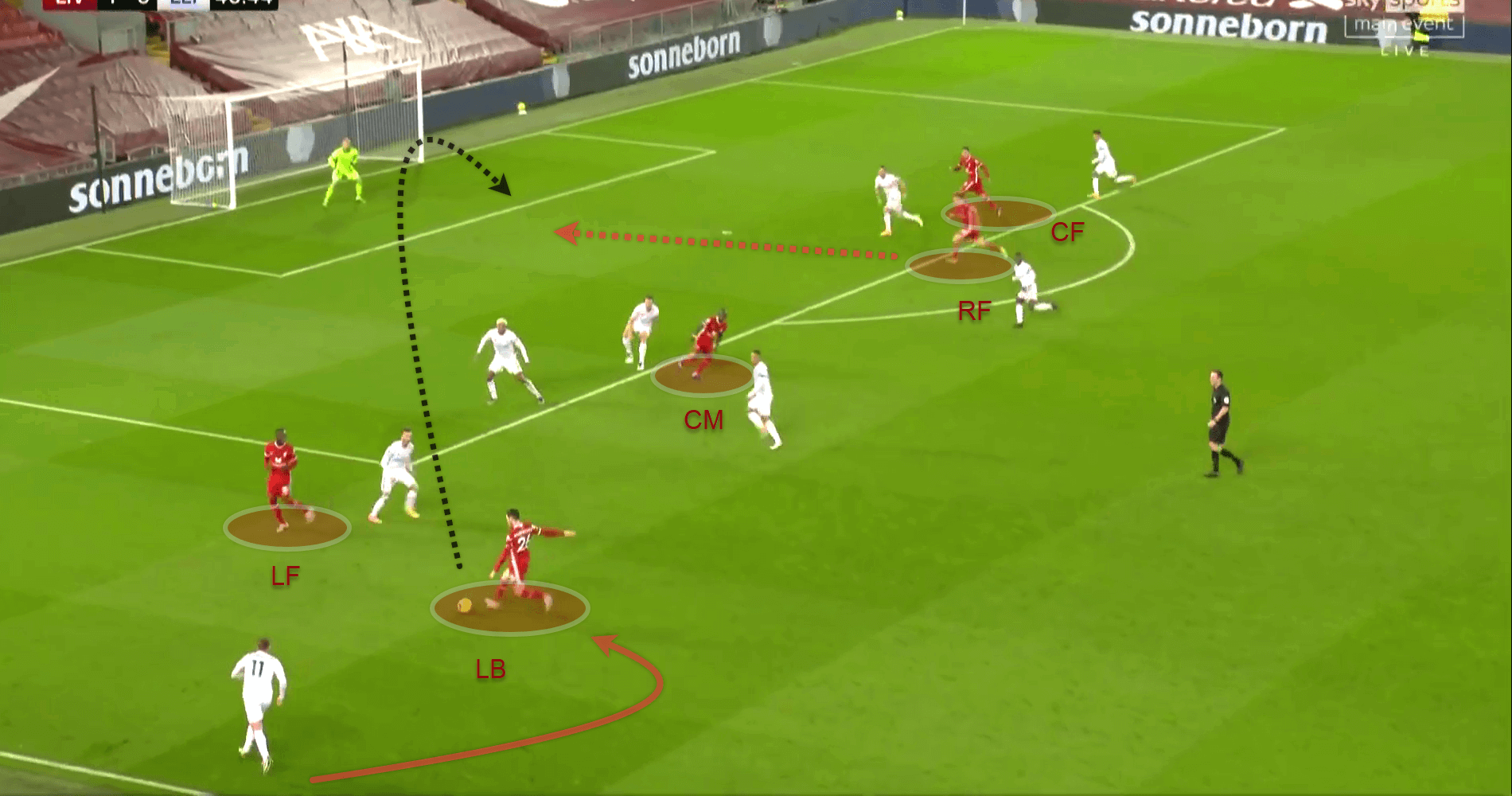
In Fig. 7. Robertson sets himself to deliver an out-swinging cross to meet the run of Jota. The Portuguese forward connects with a soft glancing header which gives Liverpool their second goal on 41 minutes. Again it is important to mention, just moments earlier Robertson received a long-crossfield pass from Milner ‘RB’. Leicester’s wing-back, Albrighton fails to close down Robertson with any real conviction and allows the Scottish full-back to come inside a bit too easy to deliver what was an excellent cross.
Such is the identity of this Liverpool side it is difficult for any side to prepare for a certain style of play or attack to neutralise the Reds. They once again showed so much dynamism and versatility with confidence going forward, either with clean passing combinations into the box or very skilful and quick forwards driving at the defenders.
The Foxes force chances from deep
As a result of sitting deep, consolidating for Liverpool’s attack and withdrawing players from the front, Leicester was not in good shape to build an attack when winning the ball back. The lack of options ahead of the ball, coupled with Liverpool’s intense counter-press, the Foxes were forced to play long passes to the lone striker, Jamie Vardy.
Liverpool did not lack respect for this Leicester City side, so much so, they were fully committed to the dark arts of the game, cutting down Leicester’s attack at their inception. Knowing Leicester are dangerous on the counter, and knowing last season’s Golden Boot winner, Vardy would be chasing down the ball, the Reds were quick to stop the attacks by any means necessary.
Liverpool committed 14 fouls in contrast to Leicester who committed only 6, a staggering statistic when you consider it was Liverpool who enjoyed spells of 70% possession in the game.
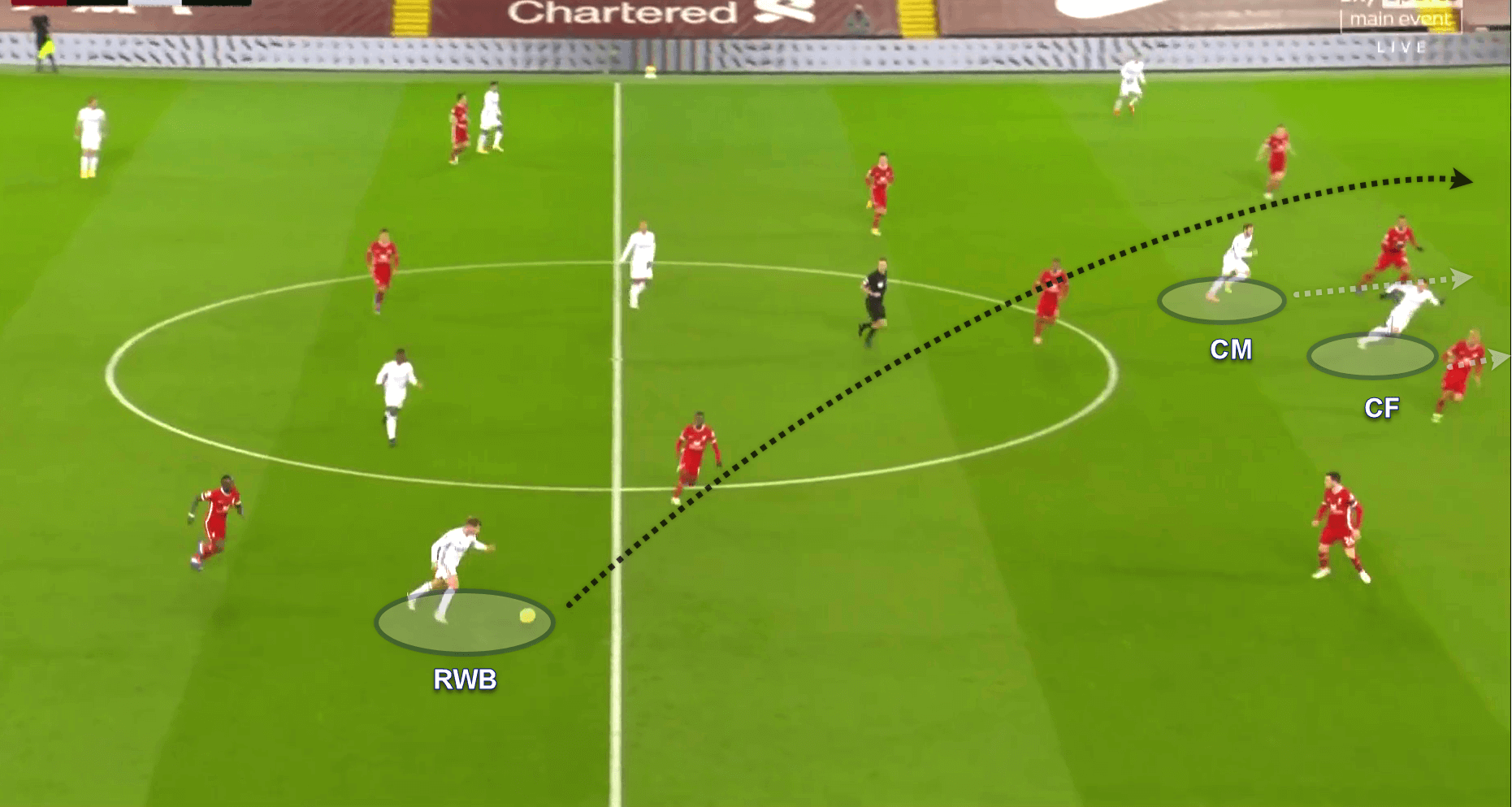
Above, in Fig. 8. Albrighton, Leicester’s wing-back receives a short pass from his centre-back and plays a long pass over the high backline of Liverpool. In early anticipation, Maddison and Vardy start their run early to beat the offside line and win the first touch of the ball.
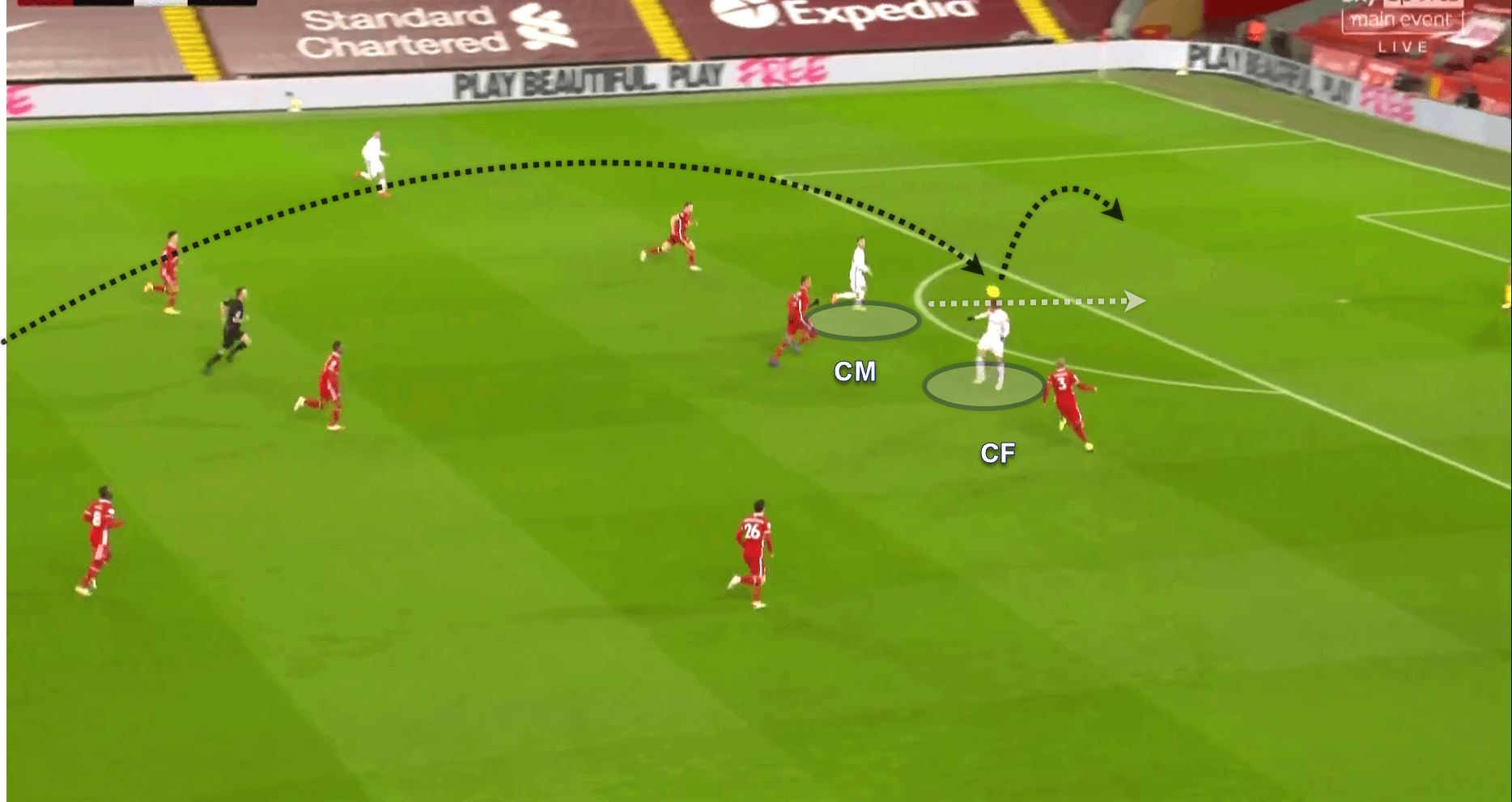
Vardy gets ahead of the defender, jumps early and offers a short flick header into the path of the ‘CM’ Maddison. At this moment Maddison takes a poor first-touch and lets an excellent goal-scoring opportunity go amiss.
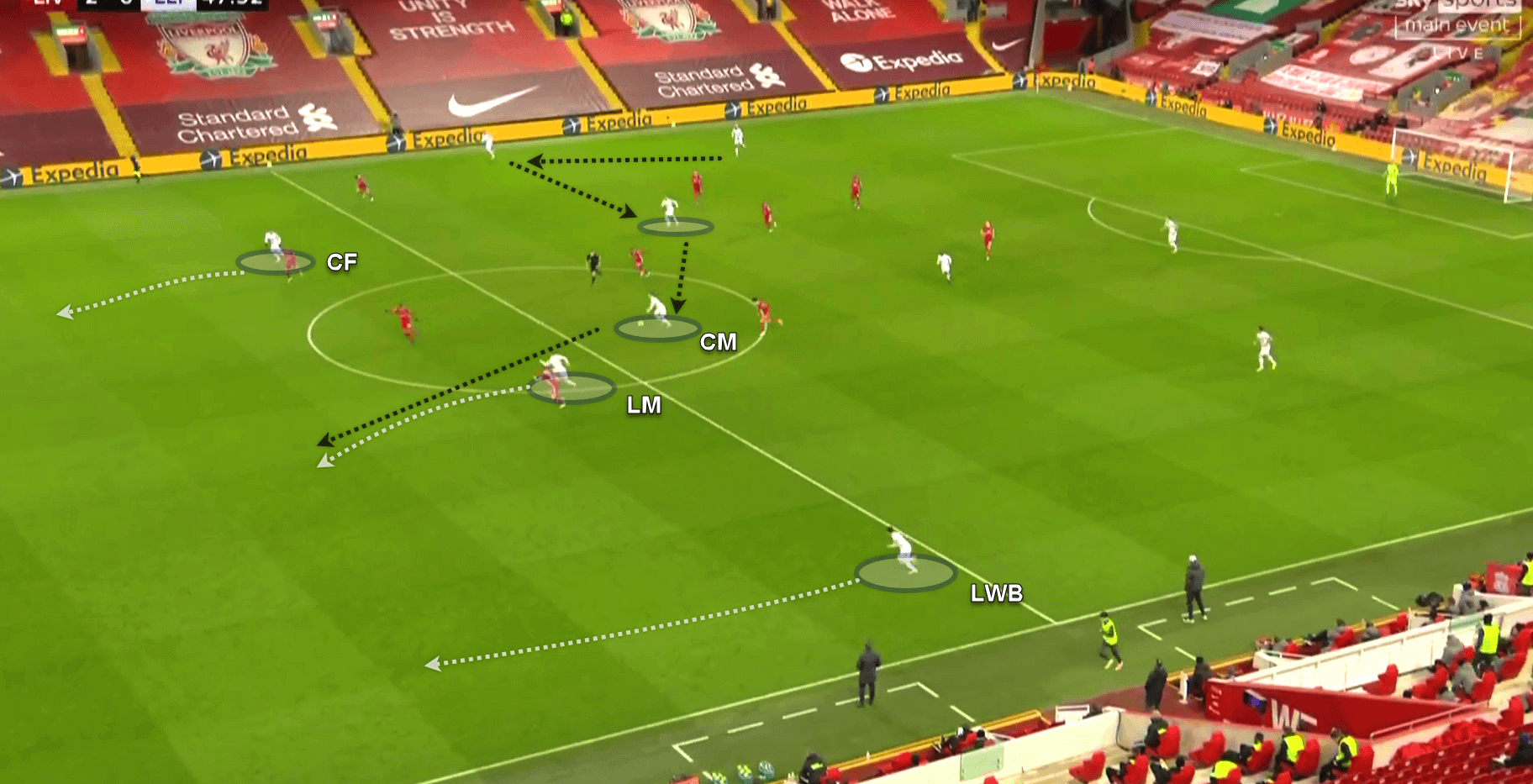
In Fig. 10. We see another direct attack from Leicester City early in the second half. A three-pass move that meets Maddison unmarked in the middle, the English midfielder then turns and plays a perfectly weighted pass forward into the run of Harvey Barnes. Observe the options left and right for the Foxes, Vardy maintains an attacking position on the right while the ‘LWB’ Justin advances to make himself an option on the left.
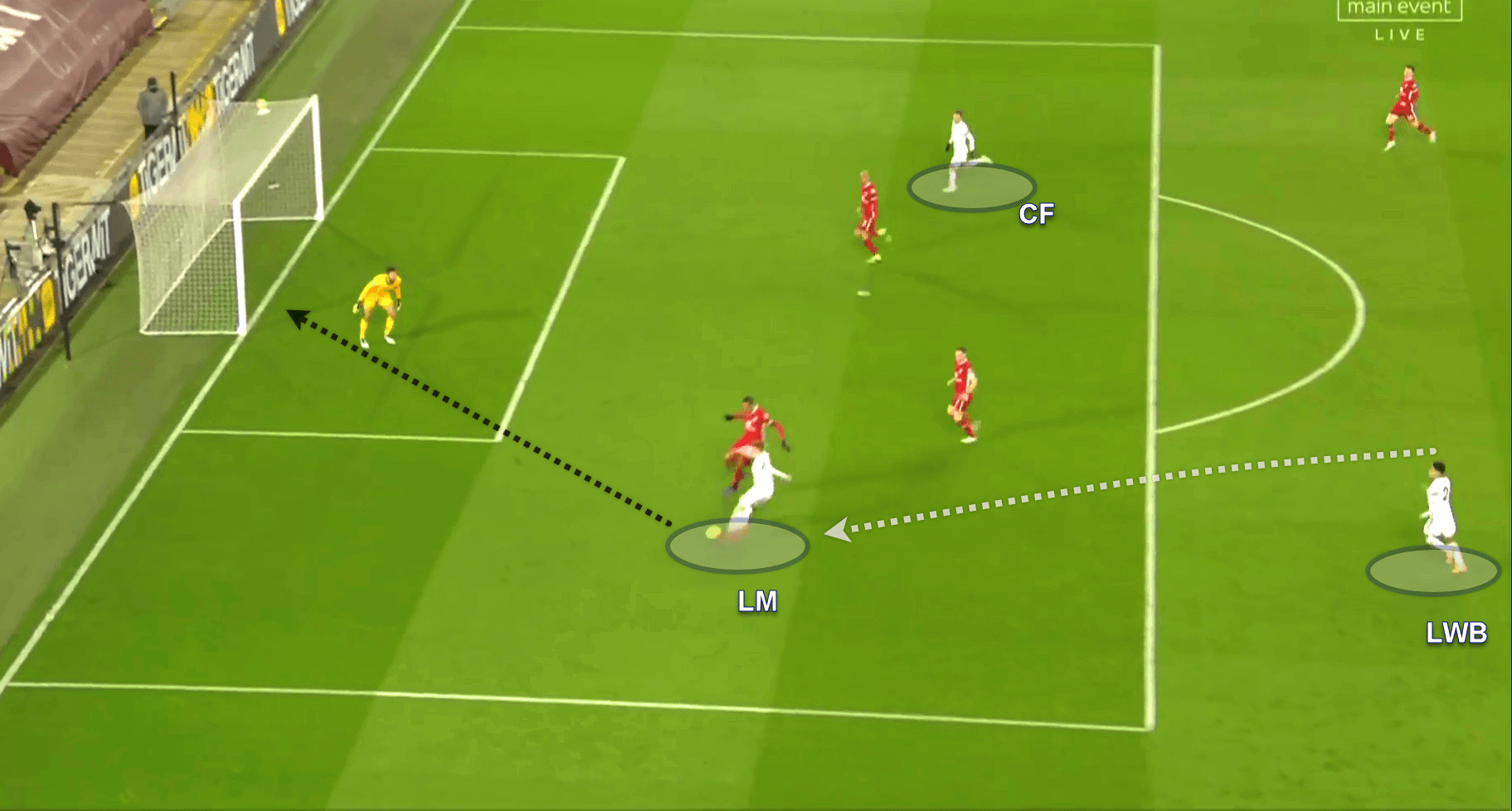
Rounding off the move, Barnes opts to stay in possession and have a goal attempt. Although he calls Alisson into action, the height and angle of the shot were comfortable enough for the Brazilian to deal with. Observe in Fig. 11. The supporting runs of Justin and Vardy who look to help finish the attack.
It was not until later in the game when Leicester switched to a 4-2-3-1 that the Foxes chose more efficient possession-based football over long passes from deep.
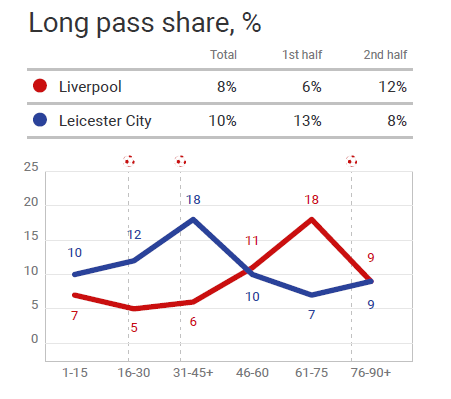
In Fig. 12. The data shows both teams percentage of passes that were considered Long Passes. A long pass is a pass considered more than 45 metres. Observe Leicester reduce their Long Pass percentage to as low as 7% after they switch to a 4-2-3-1 on 61 minutes.
Rogers reinvigorates blues
Although the Foxes were kept at bay, amounting an xG of 0.69, there is a lot to be said for how Leicester improved in the second half. At 61 minutes Rogers switches to a 4-2-3-1, giving Leicester an overload in midfield, at the same Liverpool had just lost the energetic midfield machine, Keïta to injury, it was at this point we saw The Foxes make a charge.
Switching from a 5-4-1 to a 4-2-3-1 meant Leicester could create overloads in the half-space, by having both wide midfielders tuck inside, Leicester essentially created a 5-vs-3 across the midfield. Coupled with Liverpool’s drop in pressing intensity across the front, Leicester’s defenders could play passes forward into midfield much easier before being caught in a pressing trap.
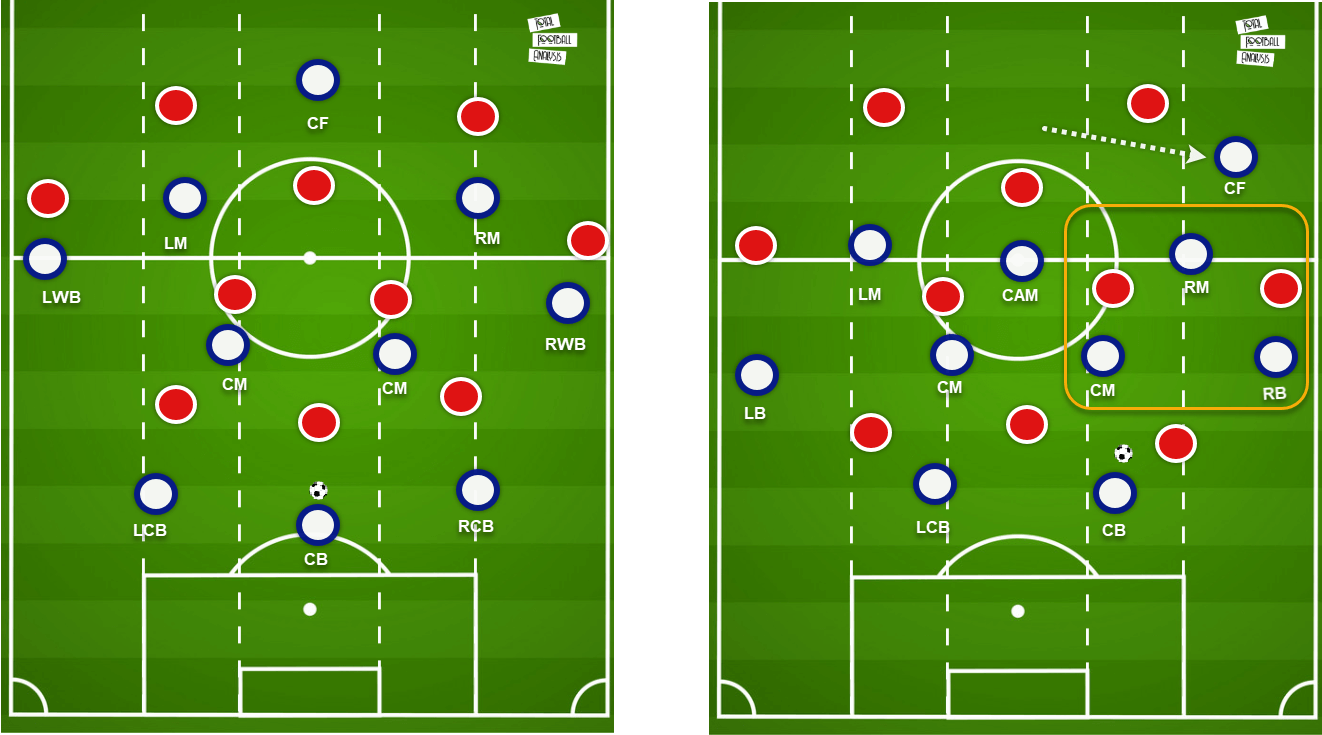
Fig. 13. Offer a tactical illustration and comparison between Leicester’s starting 5-4-1 and their second-half 4-2-3-1. Observe on the left, while playing 5-4-1, Leicester’s back five and two central-midfielders are man-marked. Although the free players are the ‘LM’ and ‘RM’, there are no realistic passing opportunities to either player when building from the back as all passing angles are screened.
While on the right, we see when Leicester move to a 4-2-3-1, observe the wide and half-space channels, it is here Leicester could create a 2v1 or 3v2 overload to progress the ball. With fluid passing combinations the Foxes could forward with ease before Liverpool could engage the press.
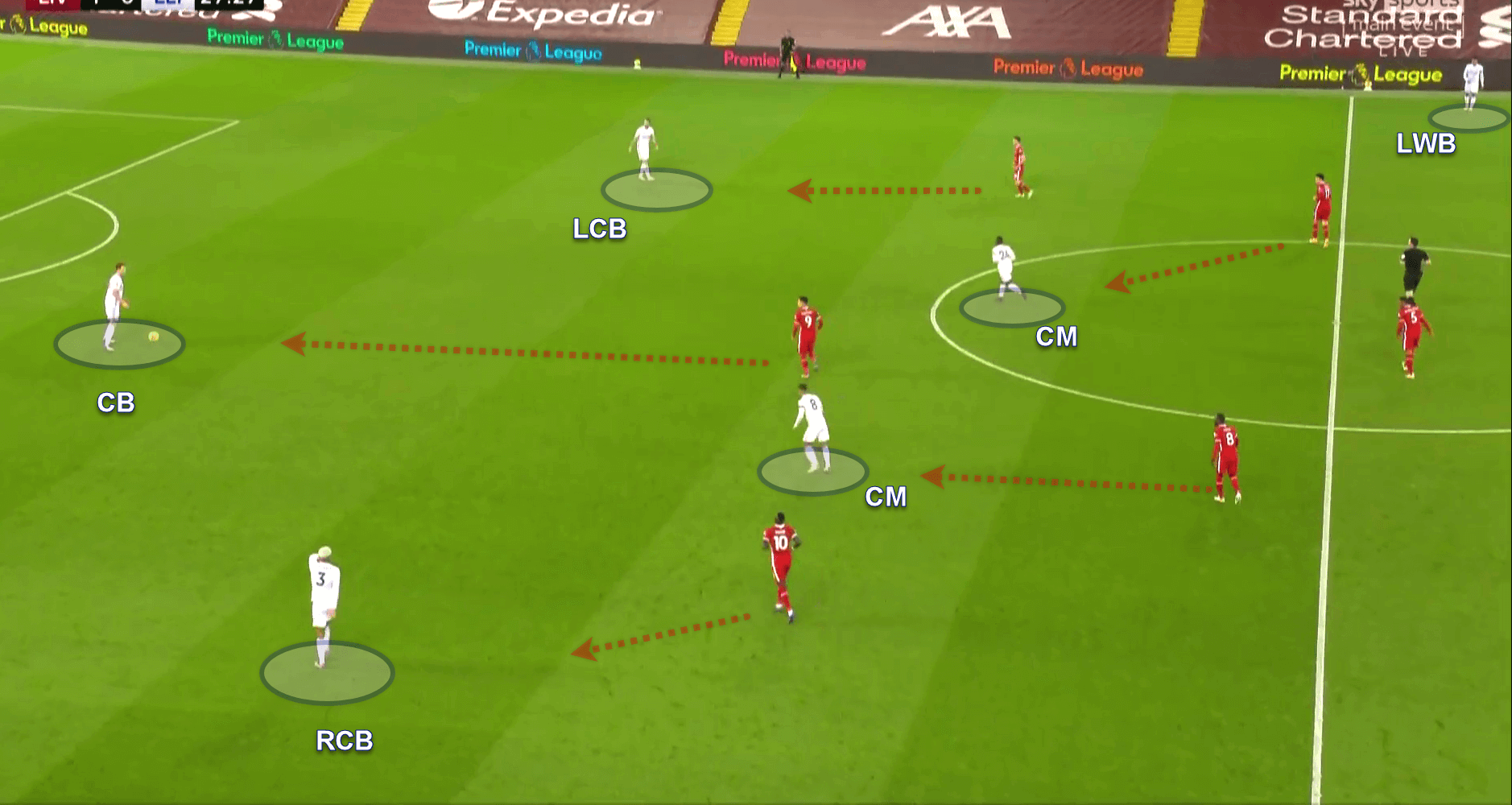
In Fig. 14. We see a moment Leicester are looking to play through Liverpool’s high-block while playing in a 5-4-1. Notice how Liverpool have each player man-marked, and there are no realistic passing options forward to advance the attack.
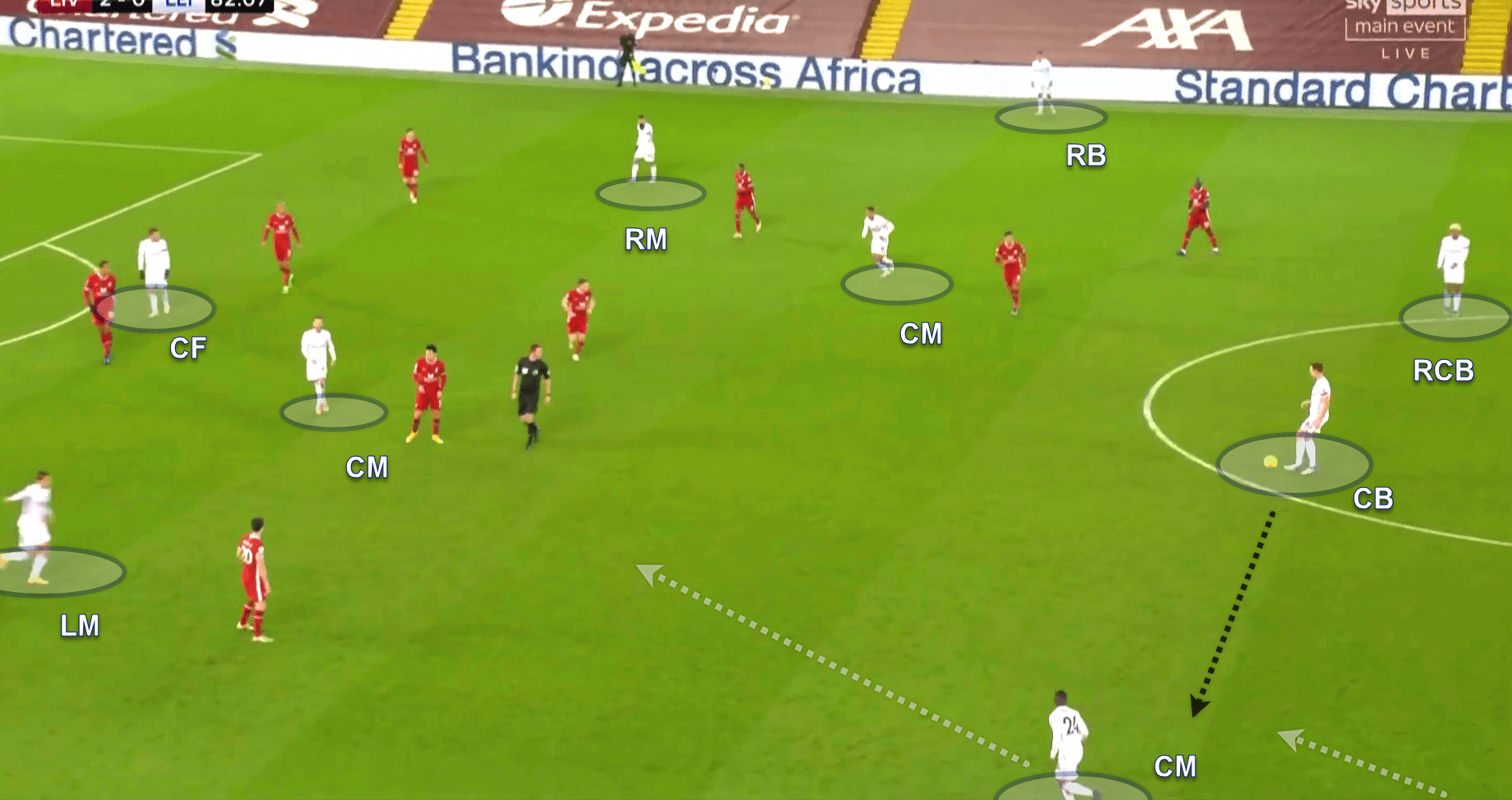
Above, in Fig. 15. We see how Leicester’s dominance in midfield forced Liverpool back into their third. Although that made a low-block Liverpool defence harder to breakdown, the higher numbers and shorter passing distances between each player in white meant they were in a better position to unlock the defence. Anchoring the attack, Evans passes to the oncoming Fuchs on his left.
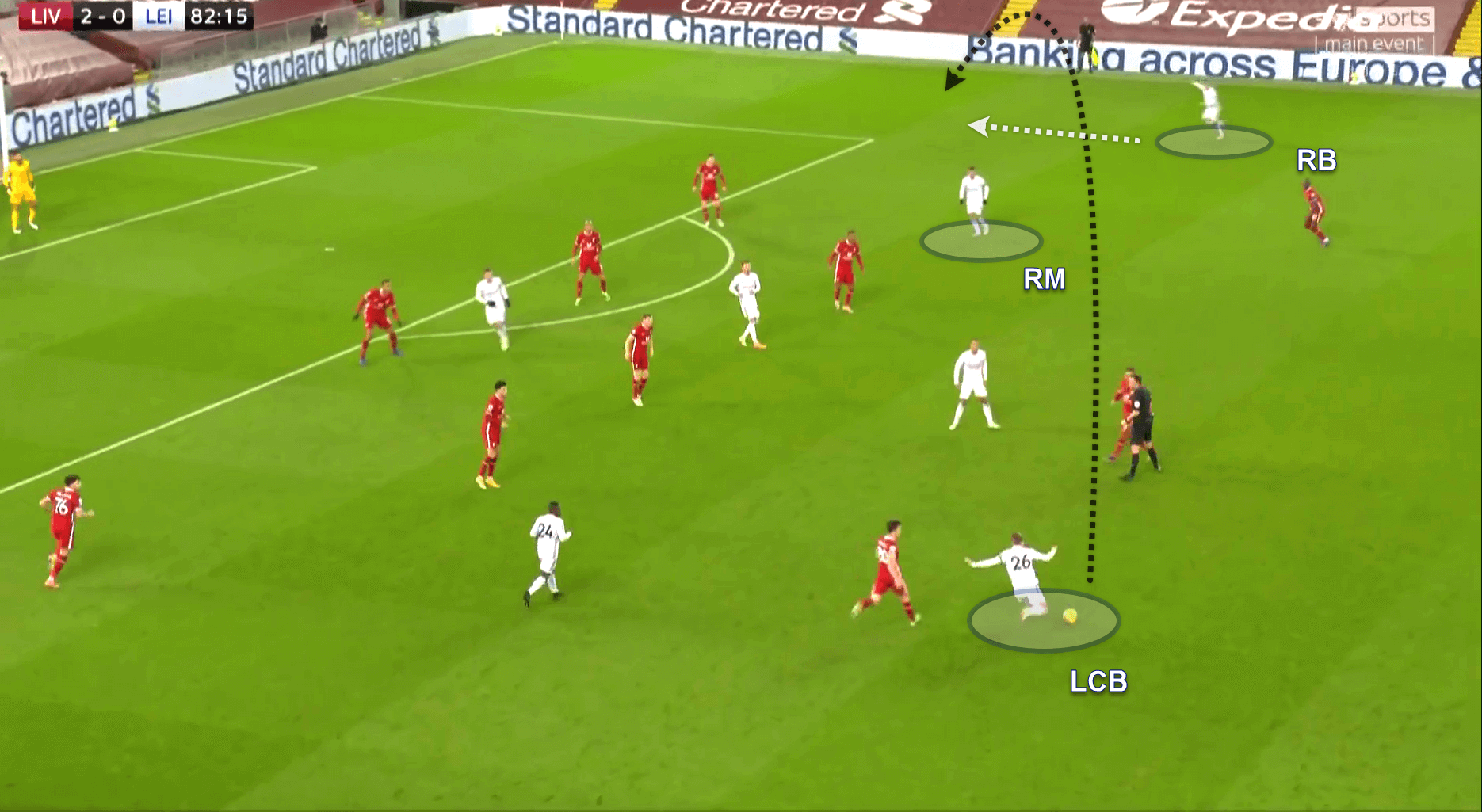
In Fig. 16. Fuchs plays a long pass to the ‘RB’ Albrighton on the weak side of the Liverpool defence. Albrighton has time to take the ball down and assess his options, at which point the ‘RM’ moves outside into the channel to create an overload.
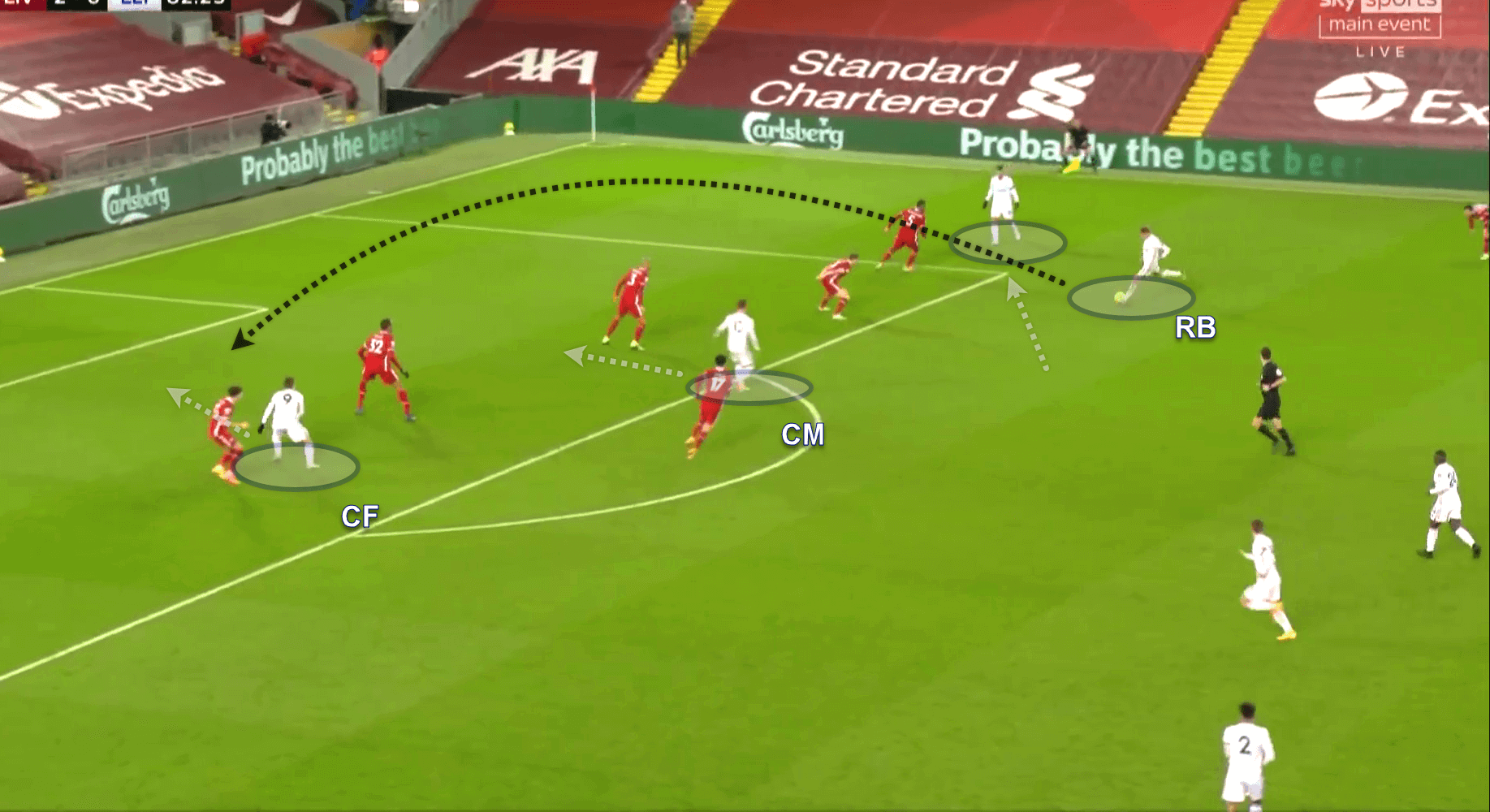
Above in Fig. 17. We see how Leicester create a better chance to score, following a combination out wide, this served to stretch Liverpool’s defence across. Ultimately, helping to unbalance the Liverpool defence centrally for a cross while the ‘RB’ Albrighton was able to move into a better position to cross to Vardy. The Liverpool goalkeeper came out to collect the cross on this occasion, Leicester continued to look a threat.
As Leicester was pushing hard for a goal to make it ‘2-1’ Liverpool won the ball back from a set-piece, immediately the Red’s countered, and subsequently got into Leicester’s third and won a corner. From this corner, Liverpool scored to make it 3-0, with the caution of being hyperbolic, that certainly was the nail in the coffin that ended Leicester’s hopes of a point.
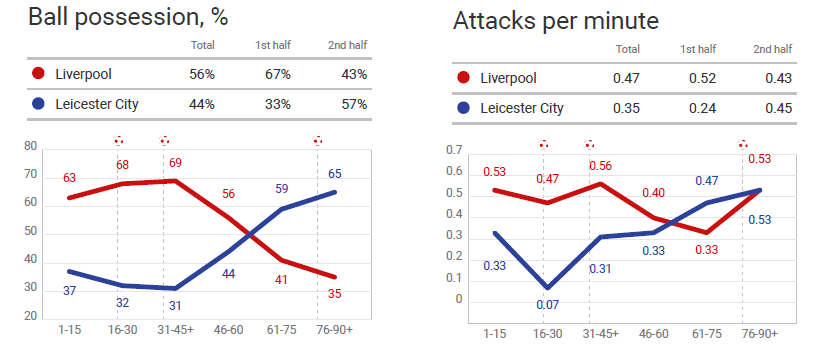
Fig. 18. Shows us two pieces of key data, ‘Possession’ on the left and ‘Attacks Per minute’ on the right. Notice how both metrics improve significantly beyond 61 minutes. It was at this point Rogers changes to a 4-2-3-1.
Conclusion
Klopp has quietened the critics, for now, those who said that a Leicester City side with a 100% away record would get the better of his depleted side were silenced. Liverpool was sharp, in and out of possession; it is their relentlessness that you have to admire. Even if there was not own goal and no goals by way of set-pieces, you just knew by the speed of their play; the Red’s would find the back of the net.
Rogers stated very clearly he was disappointed his side started so slow, lacking aggression and perhaps not reading the danger and taking responsibility. Particularly the manner of the three goals, Rogers has built a side renowned for its defensive solidity and ability to cope with crosses and ariel balls. To concede not one but three goals from crosses must have come as a shock to Leicester, 3-0 it finishes for the hosts and Rogers wait for a win over Klopp goes on.
It’s midweek action in Europe up next for both of these sides, Liverpool welcome Atalanta for UEFA Champions League action on Wednesday night while Leicester makes the away trip to Braga, Portugal in the Europa League on Thursday night. To track the progress of both of these sides be sure to check back in with us at Total Football Analysis.

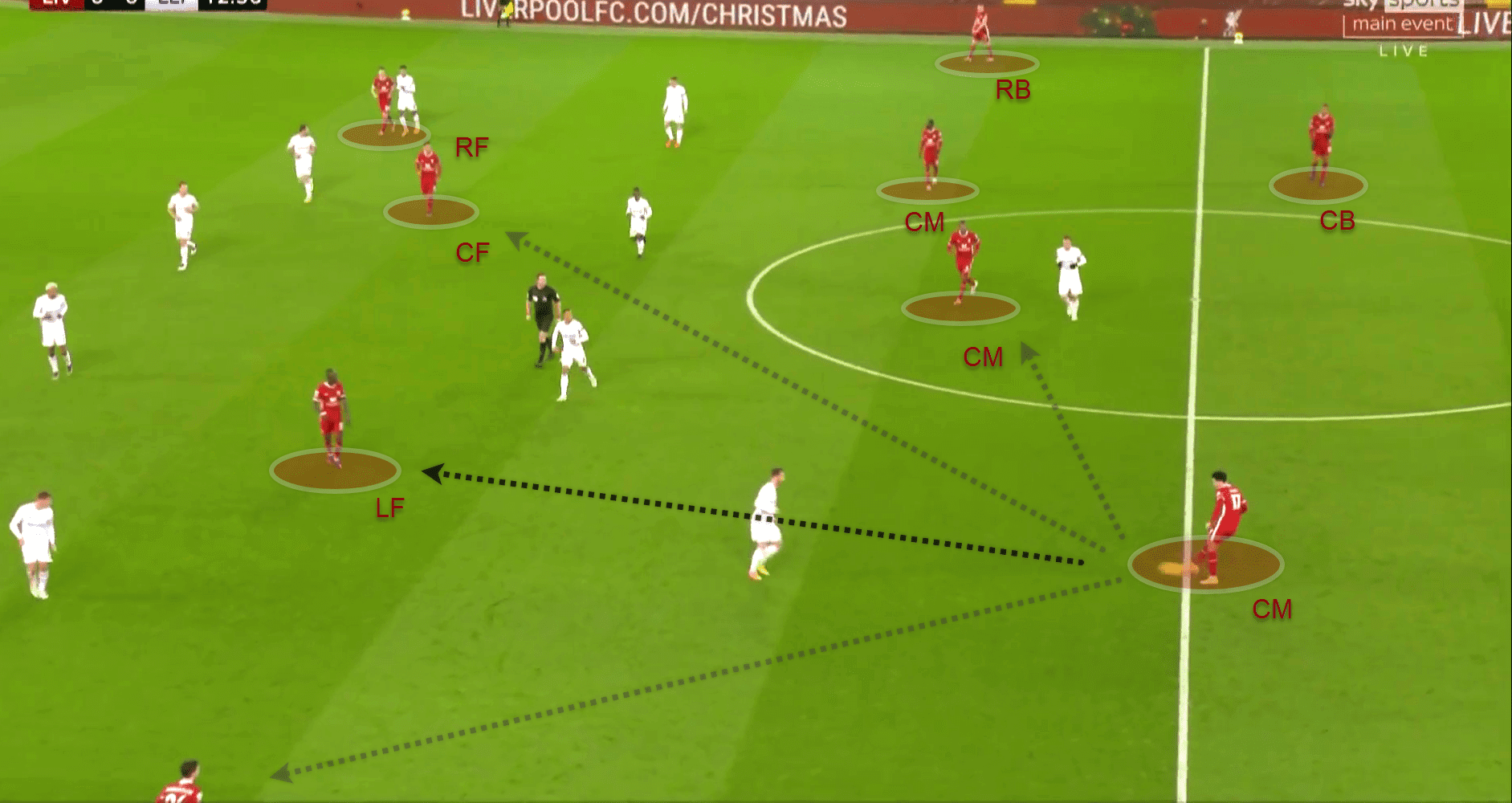



Comments